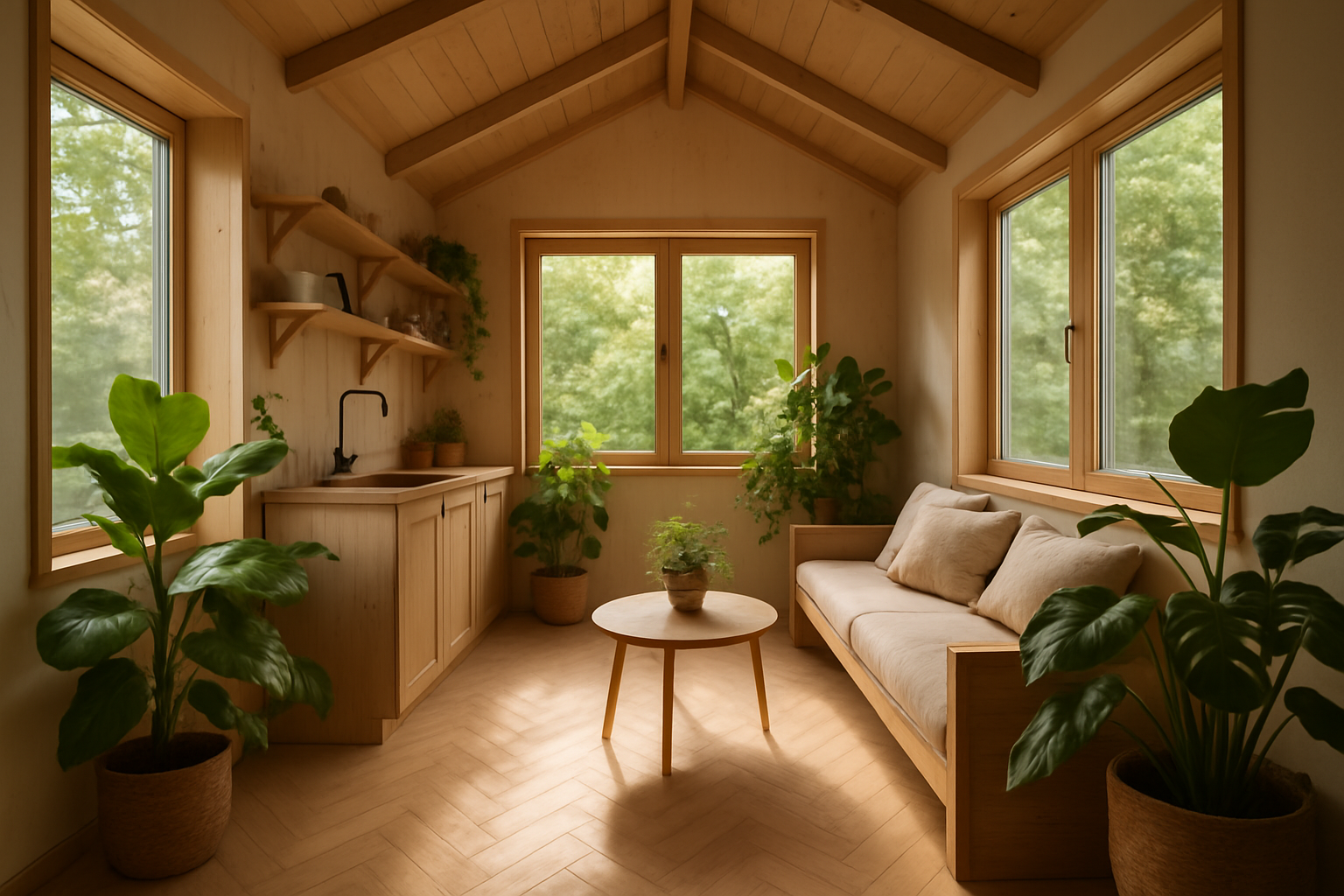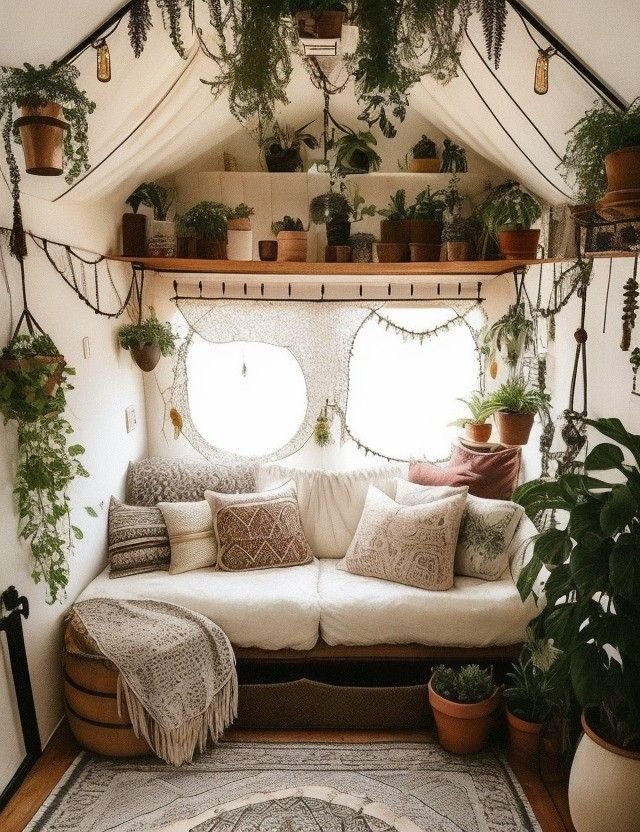In an era where simplicity and connection to nature are increasingly valued, the rustic farmhouse aesthetic has emerged as a beloved design trend, particularly within the tiny home movement. This style, characterized by its warm, inviting, and unpretentious charm, offers a perfect antidote to the sterile modernism often associated with small spaces.
For tiny house dwellers, embracing rustic farmhouse decor isn’t just about aesthetics; it’s about creating a sanctuary that feels deeply rooted, authentic, and incredibly cozy, transforming a compact footprint into a haven of comfort and character. With Pinterest reporting a staggering 403% jump in searches for “warm rustic living room,” it’s clear that the desire for nature-inspired, lived-in interiors is resonating deeply with homeowners, making this style an ideal fit for the intimate scale of a tiny house.
Table of Contents
The allure of rustic farmhouse decor lies in its celebration of natural materials, handcrafted elements, and a sense of history. It’s a style that speaks to a simpler time, evoking images of sprawling countrysides, crackling fireplaces, and generations of stories etched into weathered wood. In a tiny home, this aesthetic works magic, infusing warmth and personality into every corner, making the space feel expansive in spirit, even if limited in square footage.
This comprehensive guide will delve into the core principles of rustic farmhouse design, offering practical tips and inspiring visuals to help you infuse your tiny home with this timeless charm. We’ll explore how to incorporate weathered wood, exposed brick, vintage finds, and cozy textiles to create an interior that feels both authentic and incredibly inviting.
For those embarking on the journey of designing their tiny farmhouse dream, this article is your essential companion. We understand that every design choice in a tiny home is magnified, and selecting a cohesive style is paramount to creating a harmonious living environment. By focusing on the rustic farmhouse aesthetic, you’re not just decorating; you’re crafting a narrative, a feeling, and a deep connection to a simpler way of life.
We’ll provide actionable advice on everything from selecting the right color palette to sourcing vintage treasures, ensuring your tiny home exudes genuine farmhouse charm. Get ready to transform your compact dwelling into a warm, rustic retreat that feels like a loving embrace. For more inspiration on creating a cohesive tiny home interior, check out our article on Tiny House Color Palettes & Mood Boards: Crafting Your Perfect Compact Sanctuary.
The Foundation: Weathered Wood and Natural Textures
At the very heart of rustic farmhouse decor lies an undeniable reverence for natural materials, with weathered wood taking center stage. This isn’t about polished, pristine surfaces; it’s about celebrating the imperfections, the knots, the grains, and the rich patina that time and exposure impart. In a tiny home, incorporating weathered wood, whether through reclaimed barn wood, distressed finishes, or natural timber accents, instantly infuses the space with warmth, character, and a sense of history. It grounds the interior, creating a tactile and visually appealing backdrop that feels both authentic and inviting. Beyond wood, other natural textures like jute, linen, cotton, and wool play a crucial role in layering comfort and visual interest, contributing to the overall cozy ambiance.
Embracing Weathered Wood
•Reclaimed Wood: Sourcing reclaimed wood for accent walls, ceiling beams, or furniture pieces is perhaps the most authentic way to introduce weathered charm. Each piece tells a story, adding unparalleled character.
•Distressed Finishes: If reclaimed wood isn’t feasible, distressed wood finishes can mimic the aged look. This can be applied to new furniture, cabinetry, or even flooring to achieve that worn, loved aesthetic.
•Exposed Beams: If your tiny house design allows, exposed wooden beams on the ceiling instantly add architectural interest and a rustic touch, drawing the eye upwards and enhancing the sense of space.
•Wood Paneling: Shiplap or beadboard paneling, often painted in distressed white or a muted color, is a quintessential farmhouse element that adds texture and a clean, yet rustic, backdrop.
Layering Natural Textures
•Jute and Sisal Rugs: These natural fiber rugs add warmth, texture, and durability, perfect for high-traffic areas in a tiny home. Their earthy tones complement the rustic palette.
•Linen and Cotton Fabrics: For curtains, upholstery, and bedding, choose natural fabrics like linen and cotton. Their relaxed drape and subtle textures contribute to the informal, comfortable feel of farmhouse style.
•Wool Throws and Knits: Chunky knit blankets and wool throws draped over sofas or beds add an immediate sense of coziness and warmth, inviting relaxation.
•Wicker and Rattan: Baskets, light fixtures, or small furniture pieces made from wicker or rattan introduce organic shapes and textures, enhancing the natural, rustic vibe.
Visualizing the Impact
Consider how these elements come together to create a cohesive rustic farmhouse feel:
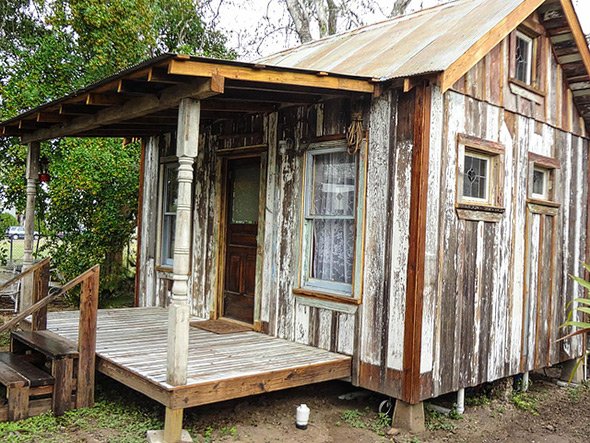
This image perfectly illustrates how weathered wood can define the character of a tiny home, creating a backdrop that feels both rugged and refined. The natural variations in the wood grain add depth and visual interest, ensuring the space feels dynamic despite its small size. The interplay of light on these textured surfaces further enhances the cozy atmosphere, making the tiny house feel like a warm embrace. For more ideas on maximizing comfort in your tiny space, you might find our article on Tiny House Interior Design Trends 2025: Where Style Meets Functionality insightful, as it touches upon how natural elements contribute to contemporary design trends.
Exposed Brick and Stone Accents: Adding Character and History
Beyond the warmth of weathered wood, exposed brick and natural stone are quintessential elements that imbue a tiny home with the authentic, grounded feel of rustic farmhouse decor. These materials, often associated with historic buildings and traditional farmhouses, bring a sense of permanence, texture, and rich character to any space. In a tiny house, where every surface is prominent, a strategically placed brick or stone accent can become a powerful focal point, adding visual depth and a touch of rugged elegance. Whether it’s a full wall, a fireplace surround, or a backsplash, these natural elements connect the interior to the earth and its raw beauty, creating a lived-in feel that is both inviting and visually captivating.
Incorporating Brick and Stone
•Accent Walls: A single wall clad in exposed brick or natural stone can dramatically transform a tiny living room or kitchen, providing a striking textural contrast to smoother surfaces. This creates an immediate sense of history and warmth.
•Fireplace Surrounds: Even in a tiny home, a small wood-burning stove or electric fireplace can be enhanced with a brick or stone surround, becoming a cozy and inviting centerpiece.
•Kitchen Backsplashes: A brick or stone backsplash in the kitchen adds a rustic touch while also being practical and easy to clean. It ties the culinary space into the overall farmhouse aesthetic.
•Faux Options: If structural or weight limitations prevent real brick or stone, high-quality faux panels or veneers can offer a convincing alternative, providing the desired look without the added bulk or cost.
The Visual Impact
Consider the raw beauty and historical resonance that exposed brick brings to a compact space:
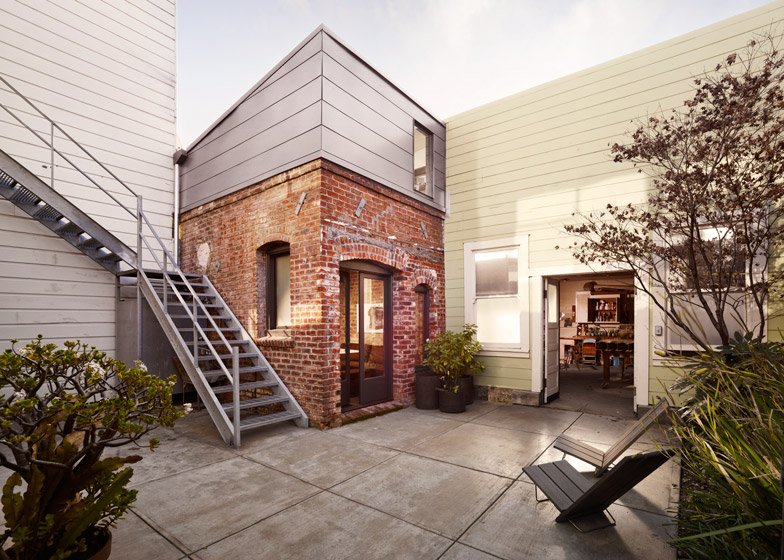
This image beautifully demonstrates how an exposed brick wall can serve as a powerful design element in a tiny home. The rich, earthy tones of the brick, combined with its inherent texture, create a sense of depth and warmth that is instantly appealing. It provides a strong visual anchor, making the space feel grounded and authentic. The contrast between the rugged brick and the smoother, lighter elements in the room highlights the farmhouse aesthetic, proving that even in a small footprint, bold design choices can make a significant impact.
The natural variations in the brickwork ensure that the wall is a dynamic feature, constantly revealing new details as the light shifts throughout the day. This kind of material choice not only adds character but also tells a story, contributing to the overall narrative of a home that feels both established and deeply personal.
Tips for Using Brick and Stone in Tiny Homes
•Balance is Key: Because brick and stone are visually heavy, balance them with lighter colors and simpler textures elsewhere in the room to prevent the space from feeling too dark or overwhelming.
•Consider Scale: Choose smaller bricks or more finely cut stone for tiny spaces to maintain appropriate scale and avoid making the wall feel disproportionately large.
•Lighting: Ensure adequate lighting to highlight the texture of the brick or stone, preventing it from appearing flat or dull. Up-lighting can create dramatic shadows that emphasize the material’s depth.
•Maintenance: Real brick and stone can be porous. Consider sealing them to protect against moisture and stains, especially in kitchen or bathroom areas.
By thoughtfully integrating exposed brick or natural stone, your tiny home can gain an unparalleled sense of character and history, truly embodying the rustic farmhouse spirit. For more ideas on adding unique touches to your tiny home, you might explore our article on DIY Tiny House Projects: Personalize Your Small Space on a Budget, which offers creative ways to incorporate custom elements.
Vintage and Antique Finds: Weaving in History and Soul
One of the most charming aspects of rustic farmhouse decor is its embrace of the past. Incorporating vintage and antique finds into your tiny home isn’t just about decorating; it’s about weaving in history, character, and a sense of soul that mass-produced items simply cannot replicate. These pieces, often found at flea markets, antique shops, or even inherited from family, tell a story and add an unparalleled layer of authenticity to your compact living space. In a tiny home, where every item is carefully curated, a few well-chosen vintage pieces can make a profound impact, transforming your interior from merely decorated to truly lived-in and loved.
The Allure of the Old
•Unique Character: Vintage items often feature unique craftsmanship, patinas, and designs that stand out. They add a distinct personality that reflects your individual taste and appreciation for history.
•Sustainability: Reusing and repurposing old items is an inherently sustainable practice, aligning perfectly with the eco-conscious ethos often associated with tiny living.
•Cost-Effective: Often, vintage finds can be more affordable than new, mass-produced furniture, allowing you to achieve a high-end look on a budget.
•Storytelling: Each antique piece carries a history, sparking conversation and adding a narrative depth to your home.
How to Integrate Vintage Pieces into Your Tiny Home
•Multi-Functional Antiques: Look for vintage pieces that can serve more than one purpose. An old wooden trunk can be a coffee table and storage, a vintage ladder can become a towel rack or display shelf.
•Small-Scale Finds: Tiny homes require careful consideration of scale. Focus on smaller vintage items like decorative crates, old metal signs, antique mirrors, or unique lighting fixtures.
•Patina and Imperfection: Don’t shy away from items with a bit of wear and tear. The distressed look, chipped paint, or faded finishes are part of the rustic farmhouse charm.
•Mix and Match: The beauty of farmhouse style lies in its eclectic nature. Combine vintage pieces with new, simpler items to create a balanced and visually interesting space.
Featured Vintage Inspiration
Imagine a tiny home infused with the warmth and character of carefully selected vintage elements:
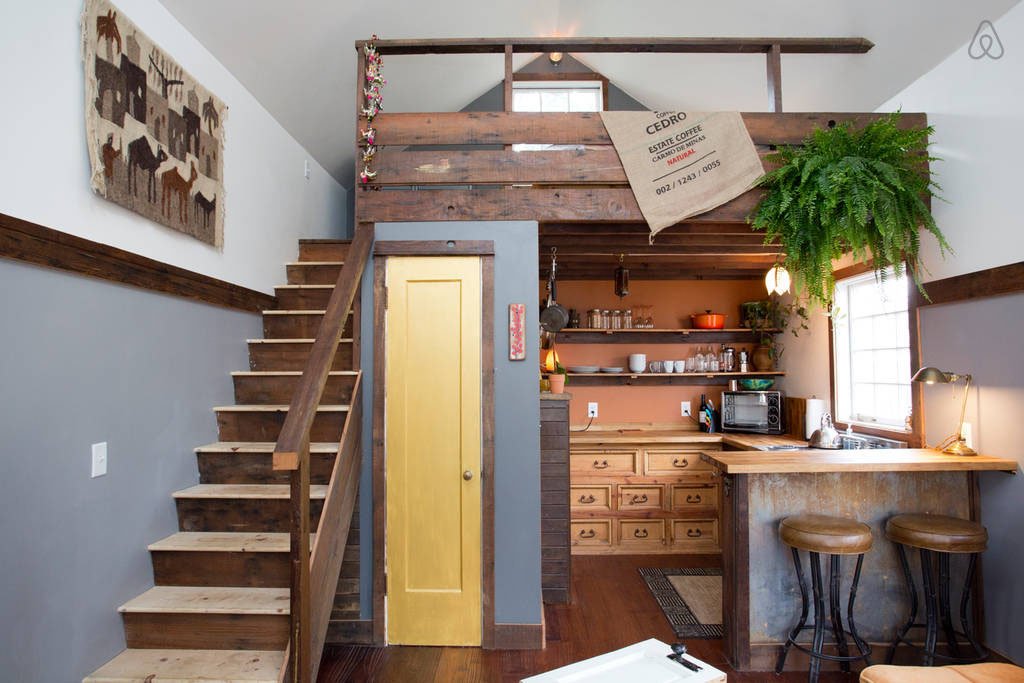
This image captures the essence of how vintage decor can elevate a tiny home. The subtle inclusion of antique-looking elements, perhaps a distressed wooden cabinet or a unique light fixture, adds a layer of depth and authenticity that feels genuinely inviting. The beauty lies in the imperfections and the sense that these items have a past, contributing to a lived-in, comfortable atmosphere. In a tiny space, such pieces become conversation starters, reflecting the homeowner’s personality and their appreciation for craftsmanship and history. The key is to select items that resonate with the overall rustic farmhouse aesthetic without overwhelming the limited space, allowing each piece to tell its own story while contributing to the cohesive narrative of the home.
Popular Vintage Items for Tiny Homes
•Galvanized Metal: Old buckets, watering cans, or tubs can be repurposed as planters, storage, or decorative accents.
•Enamelware: Vintage enamel pots, pans, and dishes add a pop of color and a nostalgic touch to the kitchen.
•Old Wooden Crates/Boxes: Perfect for open shelving, storage, or even stacked to create makeshift furniture.
•Antique Lighting: A vintage pendant light or a rustic lantern can become a stunning focal point.
•Farmhouse Sinks: While often new, a classic farmhouse sink with its deep basin and exposed front is a must-have for a truly authentic kitchen feel.
By thoughtfully curating vintage and antique finds, you can infuse your tiny home with a unique personality and a timeless charm that celebrates the beauty of the past. For more ideas on personalizing your tiny space, check out our article on DIY Tiny House Projects: Personalize Your Small Space on a Budget.
Textiles and Soft Furnishings: The Cozy Embrace of Farmhouse Style
No rustic farmhouse tiny home is complete without the comforting embrace of textiles and soft furnishings. These elements are crucial for layering warmth, adding visual softness, and enhancing the overall cozy ambiance that defines this beloved decor style. In a tiny space, where hard surfaces can sometimes dominate, the strategic use of fabrics, throws, and cushions can transform a functional dwelling into a plush, inviting sanctuary. From classic plaids and checks to natural linens and chunky knits, textiles are your secret weapon for infusing your tiny home with that irresistible farmhouse charm, making every corner feel like a warm hug.
Key Textiles for Rustic Farmhouse Decor
•Plaids and Checks: These iconic patterns are synonymous with farmhouse style, bringing a sense of traditional comfort and rustic appeal. Use them in throw pillows, blankets, or even curtains.
•Natural Linens and Cottons: Opt for unbleached or subtly textured linens and cottons for curtains, upholstery, and bedding. Their relaxed drape and breathable qualities contribute to an airy, yet cozy, feel.
•Chunky Knits and Wool: For ultimate coziness, incorporate chunky knit blankets, wool throws, or even sheepskin rugs. These add significant texture and warmth, perfect for snuggling up on a cool evening.
•Burlap and Canvas: Used sparingly, these rougher textures can add an authentic, utilitarian touch, perhaps in decorative accents or storage solutions.
Layering for Comfort and Style
•Throw Pillows: A collection of throw pillows in varying textures and patterns (plaids, solids, subtle stripes) can instantly soften a sofa or bed, adding comfort and visual interest.
•Blankets and Throws: Drape blankets and throws over furniture to invite relaxation and add layers of texture. Choose materials like wool, cotton, or faux fur for maximum coziness.
•Curtains: Simple, unlined linen or cotton curtains in a light, neutral color allow natural light to filter in while adding a soft touch to windows. Consider tie-backs made from rope or natural twine for an added rustic detail.
•Rugs: Beyond jute and sisal, consider distressed area rugs with subtle patterns or braided rugs to define zones and add warmth underfoot. Even in a tiny home, a well-placed rug can anchor a space.
Visualizing the Softness
Imagine the inviting textures that make a tiny living space feel utterly comfortable:
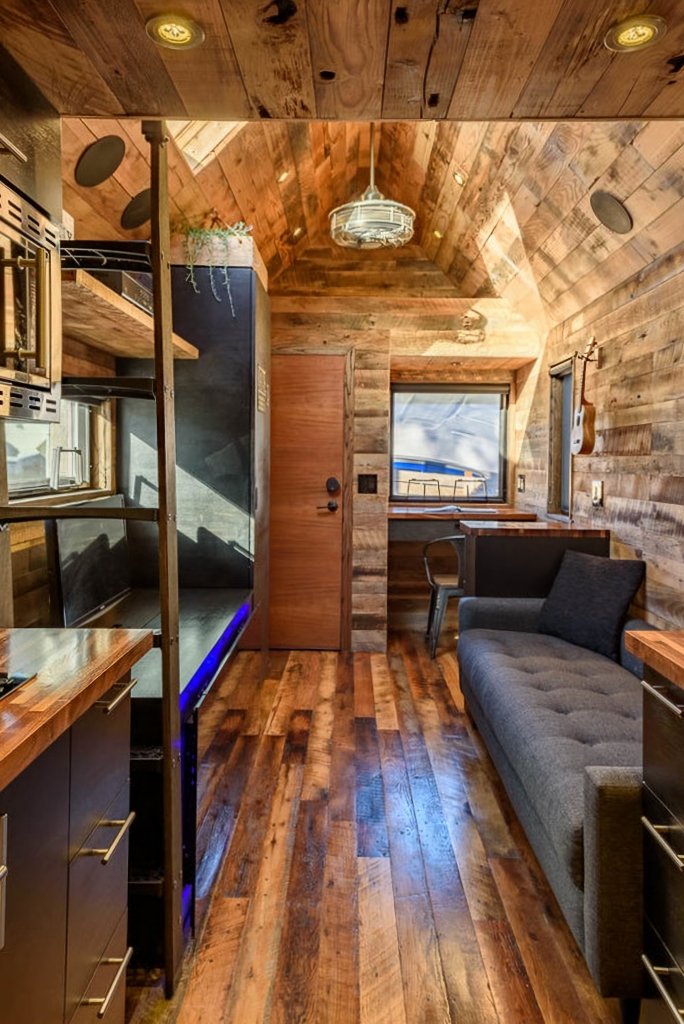
This image beautifully illustrates the power of textiles in creating a cozy farmhouse atmosphere within a tiny home. The soft, inviting textures of the plaid pillows and the chunky knitted throw instantly make the space feel more comfortable and lived-in. These elements add visual warmth and a sense of tactile comfort, inviting one to relax and unwind.
The careful layering of different fabrics and patterns, while maintaining a cohesive color palette, prevents the space from feeling cluttered, instead creating a rich and inviting environment. It’s a testament to how soft furnishings can transform a functional area into a true sanctuary, proving that even in a compact space, comfort and style can coexist harmoniously. The interplay of light on these varied textures further enhances the inviting ambiance, making the tiny house feel like a genuine home.
Practical Tips for Textiles in Tiny Homes
•Durability: Choose durable, washable fabrics, especially for items that will see a lot of use. Natural fibers like cotton and linen are often good choices.
•Storage: When not in use, blankets and pillows can be stored in multi-functional ottomans or baskets to keep the space tidy.
•Color Palette: Stick to a cohesive color palette that complements your chosen rustic farmhouse scheme. Muted tones, earthy colors, and classic neutrals work best.
•Layering: Don’t be afraid to layer different textures and patterns. This adds depth and visual interest without overwhelming the space.
By thoughtfully selecting and layering textiles, you can create a tiny home that not only looks like a rustic farmhouse but also feels like one – warm, inviting, and utterly comfortable. For more ideas on making your tiny home feel cozy, explore our article on Tiny House Storage Solutions: Maximizing Space in Your Small Home, as clever storage can contribute to a clutter-free, cozy environment.
Lighting and Fixtures: Illuminating Rustic Charm
Lighting in a tiny home is more than just illumination; it’s a critical design element that shapes the mood, highlights architectural features, and enhances the overall aesthetic. In a rustic farmhouse tiny home, the choice of lighting fixtures plays a pivotal role in reinforcing the style, adding warmth, and creating an inviting ambiance. From vintage-inspired pendants to industrial-chic sconces, the right fixtures can illuminate your space while serving as decorative accents that tie the entire design together. It’s about balancing functionality with form, ensuring that your tiny home is both well-lit and beautifully styled.
Key Lighting Elements for Farmhouse Style
•Edison Bulbs: These vintage-style bulbs with visible filaments cast a warm, inviting glow that is characteristic of rustic and industrial farmhouse aesthetics. They are perfect for exposed fixtures or pendant lights.
•Barn Lights/Gooseneck Sconces: These classic fixtures, often in matte black, oil-rubbed bronze, or galvanized metal, are quintessential farmhouse. They work well over kitchen sinks, in hallways, or as reading lights.
•Mason Jar Lights: For a DIY or more casual farmhouse look, mason jar pendants or sconces offer a charming and cost-effective lighting solution.
•Wrought Iron or Black Metal Fixtures: These materials add a touch of rugged elegance and contrast beautifully with lighter wood tones and white walls.
•Lantern-Style Lighting: Whether hanging pendants or wall-mounted lanterns, these fixtures evoke a sense of traditional charm and can be used both indoors and outdoors.
Layering Light for Ambiance
In a tiny home, layering different types of lighting is essential to create a versatile and comfortable environment:
•Ambient Lighting: This is your general illumination, often provided by ceiling-mounted fixtures or recessed lights. It ensures the entire space is adequately lit.
•Task Lighting: Focused light for specific activities, such as under-cabinet lighting in the kitchen, reading lamps by the bed, or a desk lamp in a workspace. This is crucial for functionality in a small area.
•Accent Lighting: Used to highlight architectural features, artwork, or decorative elements. This can include picture lights, small spotlights, or even string lights for a cozy touch.
Visualizing the Glow
Consider how well-chosen lighting can enhance the rustic farmhouse feel:
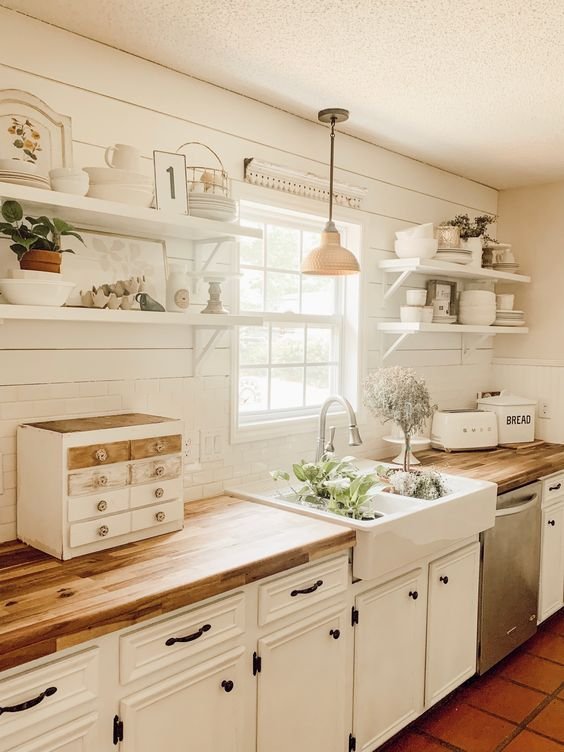
This image perfectly illustrates how appropriate lighting fixtures can elevate a tiny farmhouse kitchen. The pendant lights, likely with a metal finish, provide focused task lighting over the counter while also serving as a key decorative element that reinforces the farmhouse aesthetic. The warm glow from the bulbs complements the natural wood and white cabinetry, creating an inviting and functional space. In a tiny home, where every detail matters, such fixtures are not just sources of light but integral components of the overall design, contributing significantly to the desired rustic charm.
The strategic placement ensures that the kitchen is both practical for cooking and a visually appealing part of the open-concept living area. This thoughtful approach to lighting ensures that the space feels bright and welcoming, even within a compact footprint.
Practical Lighting Tips for Tiny Homes
•Dimmers: Install dimmers on all your lights to allow for flexible control over the ambiance. You can create bright, functional light for tasks and a softer, cozier glow for relaxation.
•Natural Light Maximization: Keep windows unobstructed and use light-colored window treatments to allow as much natural light as possible to flood the space during the day.
•Scale: Choose fixtures that are appropriately sized for your tiny home. Overly large fixtures can overwhelm the space, while too small ones might look out of place.
•Energy Efficiency: Opt for LED bulbs, which are energy-efficient and have a long lifespan, reducing the need for frequent replacements in hard-to-reach areas.
By carefully selecting and layering your lighting, you can illuminate your rustic farmhouse tiny home in a way that is both functional and beautifully enhances its cozy, authentic charm. For more ideas on designing functional and beautiful spaces, consider our article on Tiny House Kitchen Design: Maximizing Space and Functionality.
Conclusion: Your Rustic Farmhouse Tiny Home Awaits
Creating a rustic farmhouse aesthetic in your tiny home is more than just a design choice; it’s a lifestyle statement that embraces simplicity, authenticity, and a deep connection to comfort. By thoughtfully incorporating weathered wood, exposed brick and stone, vintage finds, and cozy textiles, you can transform your compact dwelling into a sanctuary that feels both expansive in spirit and profoundly inviting. This style celebrates the beauty of imperfection, the warmth of natural materials, and the stories embedded in cherished objects, making your tiny house a true reflection of your values and a haven from the bustling modern world.
Remember, the essence of rustic farmhouse decor lies in its ability to evoke a sense of history and warmth, even in a newly built tiny home. Prioritize natural textures, choose a cohesive color palette that leans into earthy tones and muted shades, and don’t shy away from mixing old with new. Every piece you select, from a reclaimed wood shelf to a vintage enamel pitcher, contributes to the rich tapestry of your home’s narrative. The result is a space that feels lived-in, loved, and uniquely yours – a cozy retreat where every detail contributes to an atmosphere of comfort and timeless charm.
Embrace the journey of curating your rustic farmhouse tiny home. It’s an opportunity to express your creativity, connect with sustainable practices, and build a space that nurtures your soul. With the right elements and a keen eye for detail, your tiny house won’t just be a place to live; it will be a testament to the enduring appeal of rustic charm, proving that even in the smallest of footprints, a grand sense of home can flourish. For more inspiration and practical advice on enhancing your tiny living experience, continue exploring the wealth of resources available on TinyHouseComfort.com.
References
[1] Pinterest Newsroom. (n.d.). Pinterest Predicts 2024. Retrieved from https://newsroom.pinterest.com/pinterest-predicts-2024/ [2] Example External Link: The Benefits of Reclaimed Wood in Home Design [3] Example External Link:

